Raise your hand if you run a coaching business and any of these sound familiar:
- A client ghosts on you for six months and then comes back wanting a refund.
- “Something” keeps coming up, and a student keeps rescheduling on you until looking at your calendar feels like playing whack-a-mole.
- A student goes broke applying the advice you gave them, and now they want to sue you.
Coaching is a human-based business. (Unless you’re coaching, I don’t know, rabbits.) And with humans come, you guessed it: human error.
That’s where a coaching contract comes in.
Contracts are about morethan wrapping your clients up in red tape and telling them what they can’t do. Think of your contract as relationship insurance: it does all the hard, boring work of keeping the relationship on rails, so you can focus on the fun part. You know. The actual coaching.
In this post, we’re going to save you a lot of time, grief, and trips to the therapist by checking off a few of the basics that should be covered in your coaching contract from day one.
Cover these areas, and you’ll never have to chase down a payment from a client who didn’t know it was due, or explain to a needy client that, no, “relationship coaching” does not include a creepy hidden camera system to walk your students through dates.
It’ll be right there, in the Disclaimer section of the contract you had them sign.
Isn’t order a beautiful thing?
Note: If you see yourself as less of a coach, more of a freelancer, check out our sister site, I Will Teach You to Be Rich — there’s a post similar to this one that goes over what freelancers should be sure to include in their contract.
P.S. Want a head start? Grab a templated version of the contract we’ll be looking at throughout this article here. Feel free to customize.
Do you need to worry about a coaching agreement right now?
In all honesty, the answer is “it depends.” Some reasons to have a contract:
- Cover your assets. Nobody likes contemplating nightmare scenarios, but the reality is they do happen: Disgruntled clients. Refund requests. On rare occasions, the threat of lawsuit. A good contract protects against all of these eventualities and keep you and yours safe. Combine a good contract with an LLC for finance and tax purposes, and you’re well on your way to making sure you’re protected on the legal front as an entrepreneur.
- Show your students you’ve got this. When a client signs up for coaching and you seal the deal with a detailed, well thought out contract, you’re letting them know: You’ve been around the block. You’ve seen some stuff. They’re in safe hands.
- Teach clients how to get the most out of your program. Your contract is just as much for your students as it is for you. With a good contract in place, students know exactly what they need to do to be successful in your program (like, show up for coaching sessions and complete the homework you give them).It also tells themwhat they can expect from you — and they can hold you accountable when you’re not holding up your end of the bargain.
- Keep the focus where it should be: on the work. When you cover off the “boring” stuff, like payment and cancellation, upfront, it frees both you and your students to focus on the reason you’re actually here in the first place: to give them the benefit of this awesome coaching program you’ve put together, and help them get those results they’ve been looking for.
In researching this post, we came across a handful of entrepreneurs who are running coaching businesses without a coaching contract in place.
Scott Barlow, founder of six-figure career coaching program Happen to Your Career, didn’t have a coaching contract in place until his business got big enough that he started bringing on other coaches to meet demand, and together they decided that putting some policies in place may be in order.
Coaching contract layout: 9 sections to include
You can start drafting the first version of your coaching contract right now. Just open a Google Doc, and create a header for each of the following sections:
- Introduction
- Disclaimer
- Payment
- Refund policy
- Rescheduling policy
- Client responsibility
- Confidentiality
- Termination
- Indemnity / Limitation of Liability
Coaching contracts are kind of like email marketing systems or logos: one of those things that you can spend hours and hours obsessing over.
So say it with me: It doesn’t have to be perfect. It just has to work.
A coaching contract doesn’t have to be the U.S. Constitution of contracts in order to do its job and be legally binding. It doesn’t even have to be in legalese.
In fact, the simpler you keep the language in your contract, the better. Coaching contracts are primarily for two people: you and your clients. The goal is for both parties to be able to read through the contract and know exactly: This is what is expected of me, and this is what I can expect in return.
Now, let’s dive into what each of these sections means and what it does for you.
For this post, we’re using Amanda Smith’s contract for her business, Solace Lessons, as an example. Amanda has had more than 300 clients sign off on this contract, and used it to settle 13 disputes, mostly for problems related to non-payment and cancellations. (Those numbers give you a ballpark as far as how often those kinds of issues come up.)
Amanda put this contract together herself, based on her own personal experience, and drawing on bits and pieces of other contracts that she’s seen that made her go, “Huh, that’s neat. Better put something like that in my contract.”
Check out a templatized version of Amanda’s contract here.
1. Introduction: Why are we here?
What it says: “You bought this coaching program. I’m going to deliver the coaching program that you bought. Make sure you read through this contract so you know what’s up.”
What it does: Sets the stage for the rest of the contract.

Like any introduction, the introduction to your contract sets the stage and lets the reader know two things:
- Why are we here?
- What is the purpose of this document?
In this case: we’re here because a student bought a coaching contract from you, the coach, and the purpose of this document is to make sure that your student understands and agrees to all the terms of the contract before you start delivering the service.
2. Disclaimer: What NOT to expect from a coaching program
What it says: “I am a coach. Not a fairy godmother.”
What it does: Protects you against unreasonable interpretations of what your services are, or what you’re able to do.
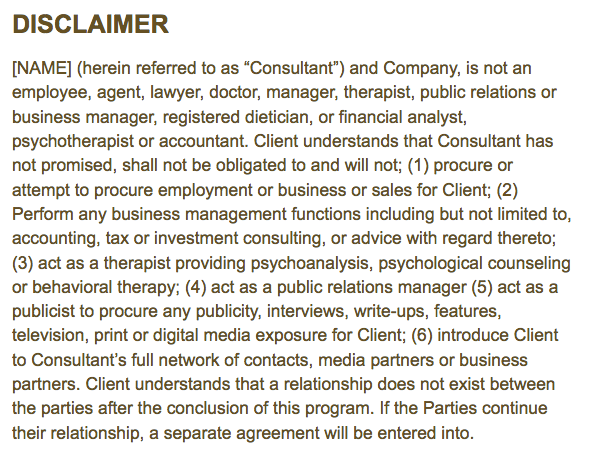
The term “coaching” can sometimes cause confusion when it comes to the level and kinds of service that coachees can expect from you. Including a Disclaimer like this one, detailing all the kinds of advice and help you are not in a position to provide — helps to clarify the relationship from the get-go.
And bonus: as the entrepreneur, it can help you define your boundaries, and the kinds of advice and help that you are and are not comfortable delivering.
BONUS: Working in the career space? Add an Earning Disclaimer.
What it says: “You and only you are responsible for the amount of money you earn by implementing this advice.”
What it does: Protects you from the expectation that your coaching is going to lead directly to increased income.
When the coaching you do is specifically tied to your students’ earning potential (maybe you’re a career coach, or you teach professional musicians how to market their talents), it adds an extra layer of expectation, because now there are numbers and livelihoods on the line.
An earning disclaimer tells coachees from the get-go: the only person who can control their earning potential is them.
3. Payment: Keep the payment trains running on time
What it says: “Here’s when and how to pay me.”
What it does: Sets clear expectations around when payment is due, so you don’t have to run around chasing after payments.
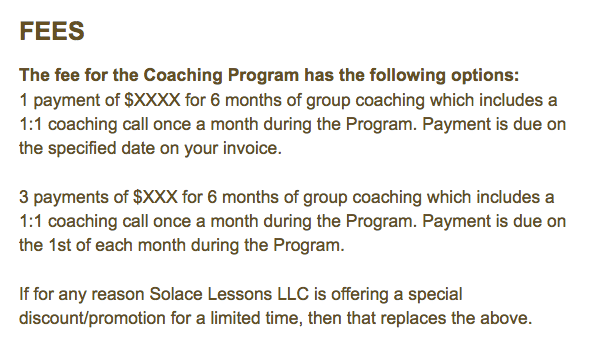
You have better things to do with your time than chase down delinquent payments. You know, things like helping your students.
Being upfront with your fees and their due dates in your contract lets your students know when they need to settle up — and lets you know when to expect the payment in your bank account.
Make your payment section as clear as possible to avoid confusion. Details you want to make sure to include:
- How much is due.
- What the payment covers.
- How the payment is structured.
- When payments are due.
…but you don’t have to take the same path as everyone else. How would it look if you designed a Rich Life on your own terms? Take our quiz and find out:
4. Refund policy: Have a policy, stick to it
What it says: “Not happy with the program? These and ONLY THESE are the terms under which I’ll give you your money back.”
What it does: Sets clear terms around when you do and do not offer refunds, so you’re protected against refunding people for whom you’ve already done the work.

Having a clear refund policy in place spares you having to agonize over whether to give a refund on a case-by-case basis.
Plus, if you cover it in your contract, and students sign off on that upfront, they know: they have 30 days (or 60 days, or 90 — you’re the business owner, it’s totally your call) to make a decision.
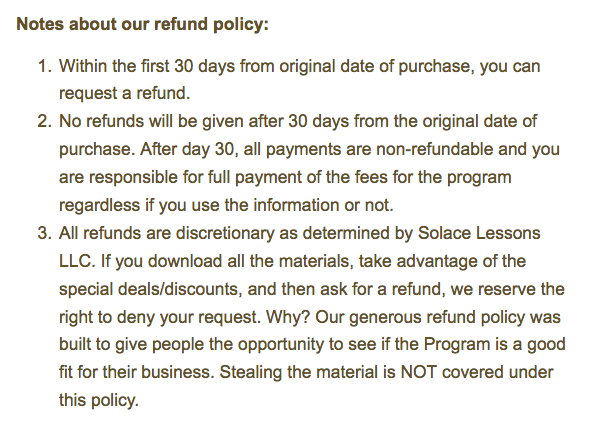
5. Rescheduling policy: Set clear boundaries upfront
What it says: “Life happens. I get it. But here’s what I need from you if you’re going to reschedule a coaching session.”
What it does: Sets clear expectations for students around how cancellations work, and what they need to do to reschedule their appointment with you.
Here’s what the rescheduling policy looks like in the Coaching Agreement for Scott Barlow’sbusiness, Happen to Your Career:
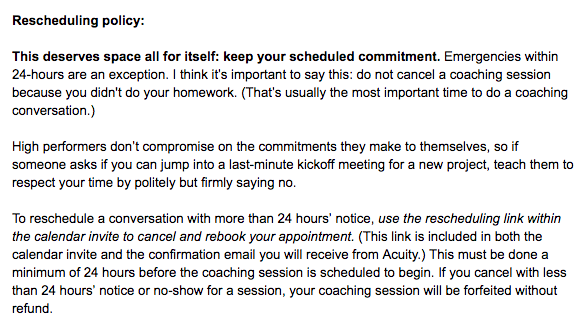
When students abuse the “reschedule” button, and it takes them weeks and months longer than it should to complete their program, not only does it throw your schedule into disarray, it potentially takes slots away that could be going to other clients. Clients who will show up. Clients who will pay.
A clear, firm rescheduling/cancellation policy nips that in the bud. It also eliminates the headaches from endless email back-and-forth trying to find another available time — a headache that’s felt on both ends.
6. Client responsibility: Help your clients help themselves
What it says: “I’ve put together an awesome program, but I’m not a miracle worker. This is your program, this is your time — if you want to get the most out of it that you can, you need to show up and do the work.”
What it does: Reminds students that in order to get the full benefit of the program, they need to be accountable for doing their part to make it a success.

This is the tricky thing about coaching: the success of the program so often depends on what the student is ready to bring to it.
If you hold up your end of the bargain, deliver an amazing coaching program jam-packed with tools and insights, and then the client doesn’t hold up theirs, should you lose out on that payment? Heck no! The Client Responsibility section covers off that and lets students know upfront: if they want the results, they need to put in the effort.
7. Confidentiality: What happens in coaching stays in coaching
What it says: “Your information is yours, my information is mine. Let’s not either of us share the other’s information without permission.”
What it does: Protects you AND your client from information getting shared that you don’t want shared.
Coaching relationships are about trust. Your students are sharing sensitive information with you, from their payment info to their email address, to the details about their lives shared during sessions. They deserve to know that that information is taken care of.
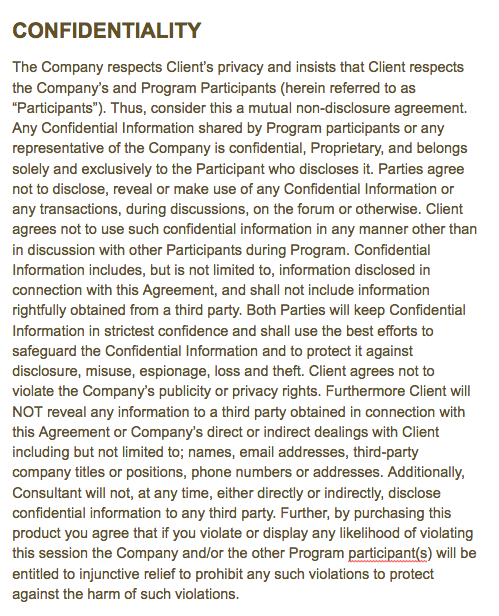
But that trust is a two-way street. Just as important as the expectation that you’ll protect your client’s info is the expectation that they’ll protect yours: specifically, the materials and exercises that you share with them as part of your program.
Copyright infringement is a real threat to information product entrepreneurs, and coaches in particular. Your students might not even realize that, by sharing a worksheet that you gave them, they’re potentially infringing on your intellectual property.
Covering off this information early can prevent crossed signals and bad feelings, and ensure that you and your clients are on the same page about what’s shareable material — and what isn’t.
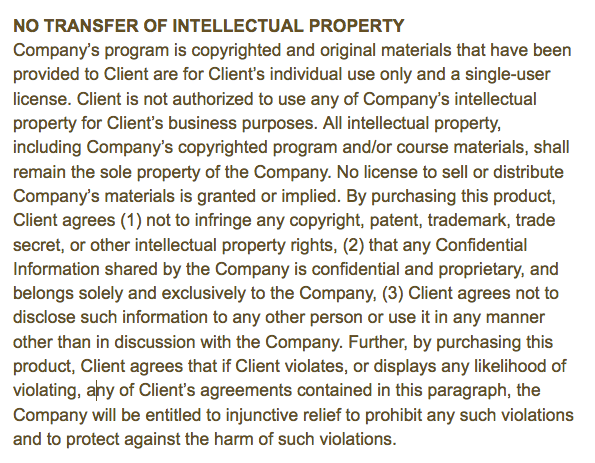
8. Termination: Like a prenup for your business
What it says: “I want you to get the most out of this program that you can. But I reserve the right to fire you as a client.”
What it does: Gives you a legal “way out” in the event that you need to part ways with a particularly toxic client.

This is the “nuclear option” of the coaching world: you should really only break up with clients if the feeling is mutual, or if you know deep down to the core of your coaching soul that there’s nothing you can do to help them.
9. Indemnity: The CYA clause
What it says: “Look, sometimes things don’t go right. Let’s settle things like level-headed adults and not like … overly litigious adults.”
What it does: Protects you against legal liability in the event something should go really wrong.
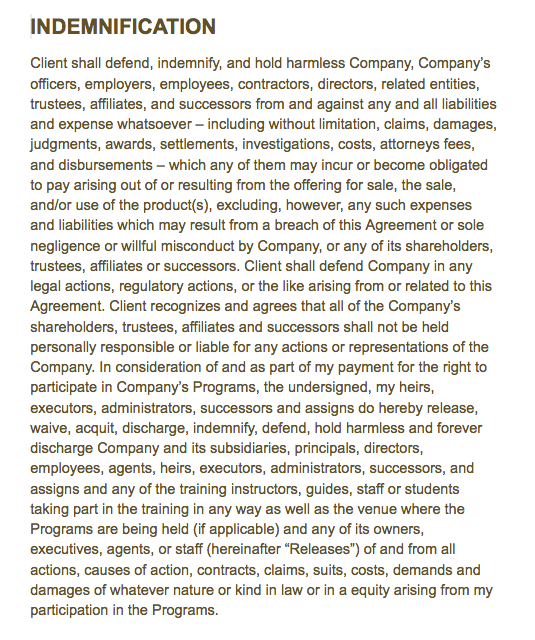
Call this the “shit hits the fan” section of the contract. It’s the section that covers what will go down if the absolute worst should occur: like if a client refuses to pay for their sessions, or if they sue you.
Note: Most of the sections we’ve gone over are things that you can draft yourself. But the indemnity clause is one where it really is worth your while to have a legal professional look it over, just to make sure it covers all the bases that it needs to cover to hold up in court.
Are you short on legal help these days? Here’s a list of lawyer organizations that provide pro-bono legal services.
So what now?
Now you have all the information you need to start framing out the very first version of your coaching contract.
What happens after you create your contract? You’re ready to start sending it! No need to freak out over what software platform is best for contract record-keeping right now — Amanda sends her contract to clients via email and just asks them to send her an email letting them know they got it.
Remember: It doesn’t have to be perfect. It just has to work. There will be plenty of opportunities to revisit and refine your contract. In fact, you should plan on revisiting your contract every time you take on a new client or open a new round of coaching.
So for now, go ahead: open up a Google Doc (or copy our template of Amanda’s contract, found here). Label it “Coaching Contract v.1” or something like that, and create a subhead for each of these categories.
Then, start framing out:
- Introduction. What did this person just buy from me? What do I expect them to do with this contract?
- Disclaimer. What services am I not able to provide within the context of this program? What promises am I not able to make?
- Payment. How do I expect students to pay for the coaching they receive?
- Refund policy. How am I going to handle it when people want their money back?
- Rescheduling policy. How am I going to handle it when clients say they can’t make their appointment and want to reschedule?
- Client responsibility. What do my coachees need to do to hold up their end of this bargain?
- Confidentiality. What promise do I want to make to my coachees about their private information, and what do I expect from them in return?
- Termination. Under what terms do I consider this contract to be null and void?
- Indemnity / Limitation of Liability. If the worst-case scenario happens, how am I protected?
Coaches, we want to hear from you: How did you put together your first coaching contract? Is there a section of your coaching contract that you’d be lost without? What do you WISH you’d included in the first version of your contract, but didn’t? Share your thoughts in the comments below!
If you liked this post, you’d LOVE our Ultimate Guide to Remarkable Content
It’s one of the best things we’ve published, and totally free – just tell us where to send it:
